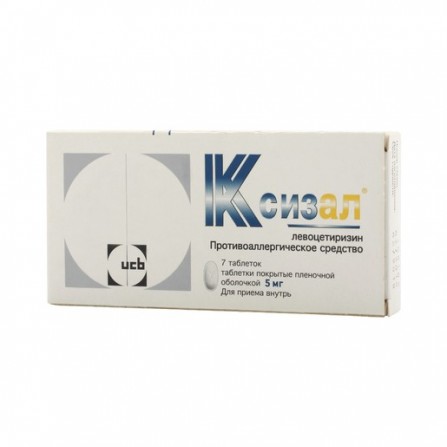Ksizal pills coated 5mg N7
Condition: New product
1000 Items
Rating:
Be the first to write a review!

More info
Active ingredients
Levocetirizine
Release form
Pills
Composition
Active ingredient: Levocetirizine dihydrochloride Concentration of active ingredient (mg): 5
Pharmacological effect
The histamine H1 receptor blocker, cetirizine enantiomer, belongs to the group of competitive histamine antagonists. The affinity for histamine H1 receptors in levocetirizine is 2 times higher than that of cetirizine. Levocetirizine affects the histamine-dependent stage of allergic reactions, and also reduces the migration of eosinophils, reduces vascular permeability, limits the release of inflammatory mediators. It prevents the development and facilitates the course of allergic reactions, has anti-exudative, antipruritic action, practically does not have anticholinergic and antiserotonin action. In therapeutic doses, almost no sedative effect.
Pharmacokinetics
Absorption The pharmacokinetic parameters of levocetirizine vary linearly and are practically the same as cetirizine pharmacokinetics. After oral administration, levocetosirzine is rapidly absorbed from the gastrointestinal tract. Meal does not affect the degree of absorption, although its rate decreases. After a single ingestion in a therapeutic dose of Cmax in adults, plasma is reached after 0.9 h and is 207 ng / ml, after repeated administration at a dose of 5 mg / day - 308 ng / ml. Bioavailability is 100%. The distribution of Css is achieved in 2 days. The binding of levocetirizine to plasma proteins is 90%. Vd is 0.4 l / kg. Metabolism Less than 14% is metabolized in the liver by N- and O-dealkylation (unlike other histamine H1-receptor blockers that are metabolized in the liver with the participation of cytochrome P450 isoenzymes) with the formation of a pharmacologically inactive metabolite. Due to the low level of metabolism and the lack of metabolic potential, the interaction of levocetirizine with other drugs seems unlikely. Intake of adults is 7.9 ± 1.9 h, the total clearance is 0.63 ml / min / kg. About 85.4% of the dose is excreted by the kidneys unchanged by glomerular filtration and tubular secretion; about 12.9% is excreted through the intestines. The pharmacokinet in special clinical situations in patients with renal insufficiency (CC less than 40 ml / min), the clearance of levocetirizine decreases, and T1 / 2 increases (in patients on hemodialysis, the total clearance decreases by 80%), which requires a corresponding change in dosing regimen.Less than 10% of levocetirizine is removed during a standard 4-hour hemodialysis procedure. In young children, T1 / 2 is shortened.
Indications
For adults and children over 6 years of age: treatment of symptoms of year-round and seasonal allergic rhinitis and allergic conjunctivitis, such as itching, sneezing, tearing, conjunctival hyperemia; hay fever (pollinosis); urticaria, including chronic idiopathic urticaria, angioedema; other allergic dermatosis, accompanied by itching and rash.
Contraindications
Hypersensitivity to any of the components of the drug or piperazine derivatives. Severe chronic renal failure (creatinine clearance less than 10 ml / min). Children's age (up to 6 years). With care - chronic renal failure (correction of the dosing regimen is required), advanced age (reduction of glomerular filtration is possible).
Precautionary measures
Do not exceed the recommended dose. The drug should be used with caution in case of chronic renal failure (correction of the dosing regimen is required), in elderly patients (with age-related reduction of glomerular filtration).
Use during pregnancy and lactation
Adequate and strictly controlled clinical studies on the safety of the drug in pregnant women have not been conducted, so Xyzal should not be prescribed during pregnancy. Levocetirizine is excreted in breast milk, so if you need to use the drug during lactation, you should stop breastfeeding. animals did not reveal any direct or indirect adverse effects of levocetirizine on the developing fetus (including in the postnatal period ), Pregnancy and childbirth are not changed.
Dosage and administration
It is applied inside with food or on an empty stomach, washed down with a small amount of water, without chewing. Adults and children over 6 years old: daily dose - 5 mg (1 tablet). Elderly patients (subject to normal renal function) dose reduction is not required. For patients with chronic renal failure, the dose is halved (1 tablet every other day) with QA from 30 to 49 ml / min and 3 times (1 tablet in 3 days) with QC from 10 to 29 ml / min.Patients with liver failure do not need to adjust the dosage regimen. The duration of treatment depends on the disease. For the treatment of pollinosis prescribed on average for 1-6 weeks. In chronic diseases (year-round rhinitis, atopic dermatitis), the duration of treatment may increase to 18 months.
Side effects
Headache, drowsiness, dry mouth, fatigue. Rarely - migraine, dizziness, dyspeptic disorders, allergic reactions (angioedema, rash, urticaria, itching).
Overdose
Symptoms: drowsiness (in adults), agitation and anxiety, alternating with drowsiness (in children). Treatment: immediately after taking the drug, wash the stomach or induce artificial vomiting. It is recommended the appointment of activated carbon, conducting symptomatic and supportive therapy. There is no specific antidote. Hemodialysis is ineffective.
Interaction with other drugs
The study of the interaction of levocetirizine with other drugs was not carried out. When studying the drug interaction of the racemate cetirizine with pseudoephedrine, cimetidine, ketoconazole, erythromycin, azithromycin, glipizide and diazepam, we did not reveal any clinically significant undesirable interaction. cetirizine is reduced by 16%, theophylline pharmacokinetic parameters do not change. In some cases, the simultaneous use of levocetirizine with ethane scrap or drugs, have a depressing effect on the CNS, may enhance their effect on the central nervous system, although it is proved that the racemate cetirizine potentiate the effect of alcohol.
special instructions
The patient should be careful when taking the drug and the simultaneous use of alcohol. The effect on the ability to drive vehicles and control mechanisms. At an objective assessment of the ability to drive vehicles and work with mechanisms, no adverse events were clearly observed when prescribing the drug at the recommended dose. However, during the period of treatment, it is advisable to refrain from engaging in potentially hazardous activities that require increased concentration and psychomotor speed.




